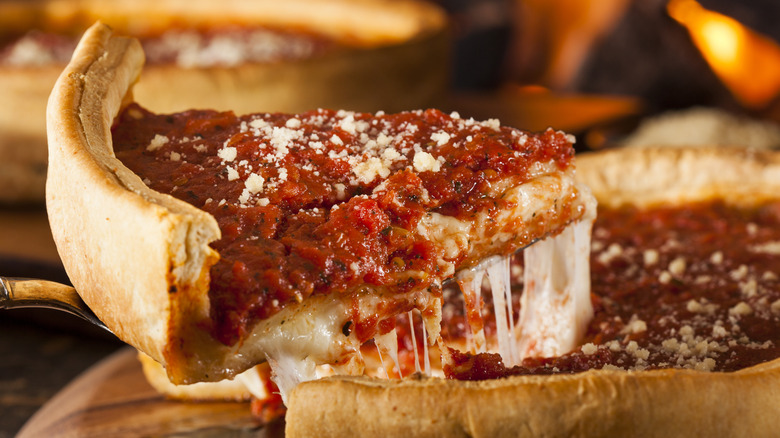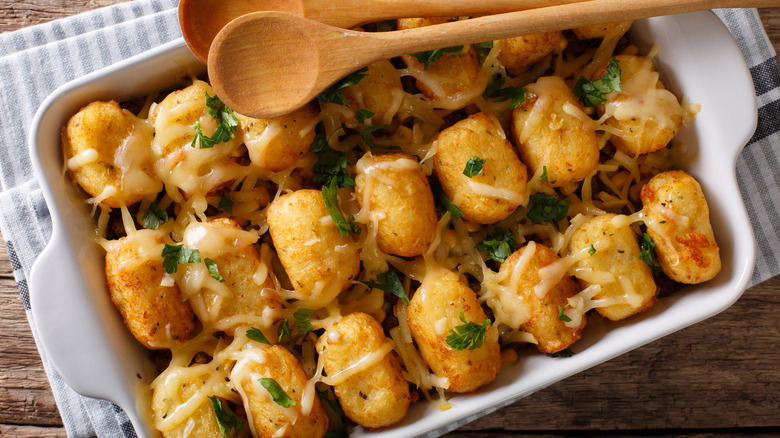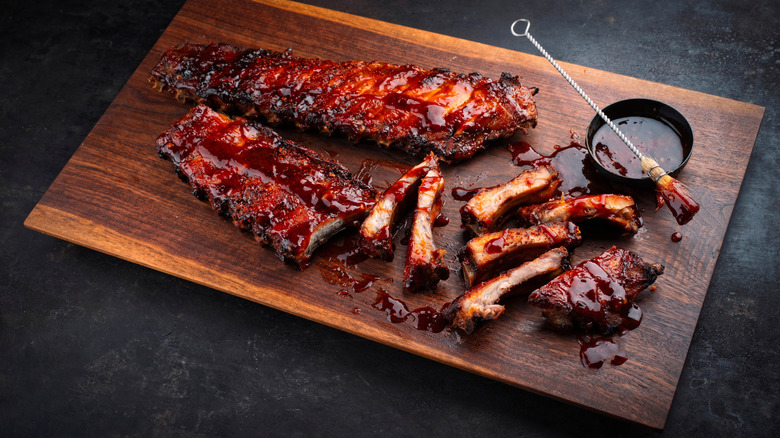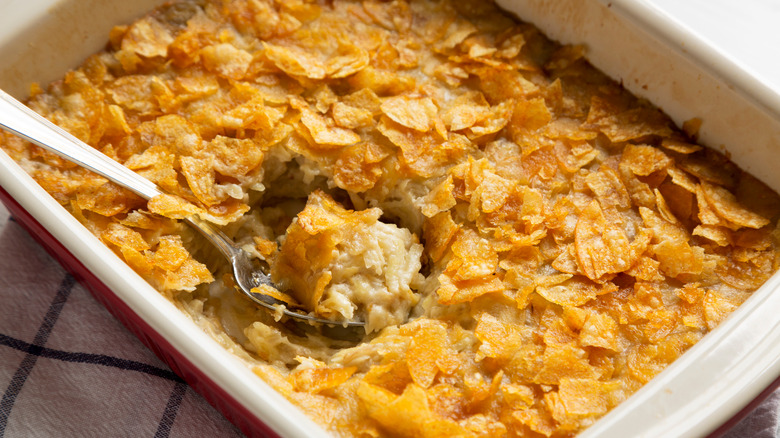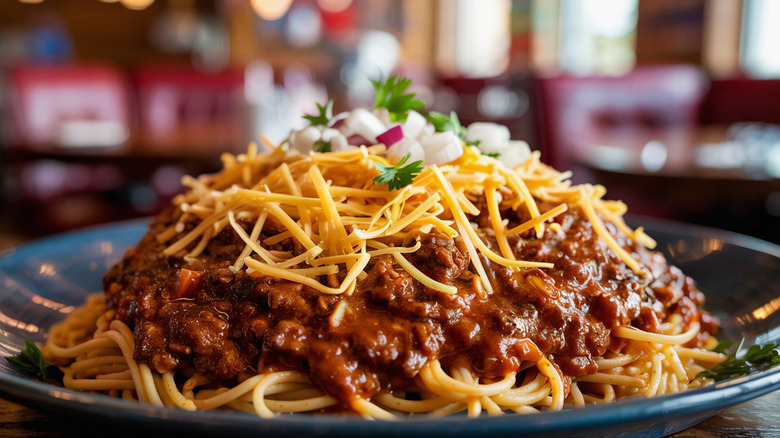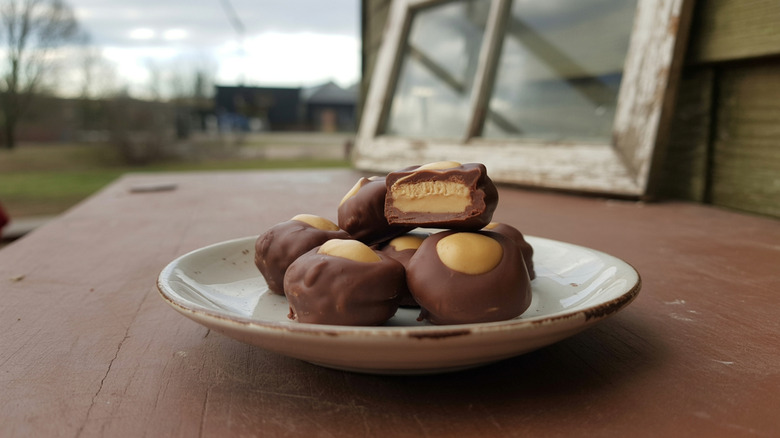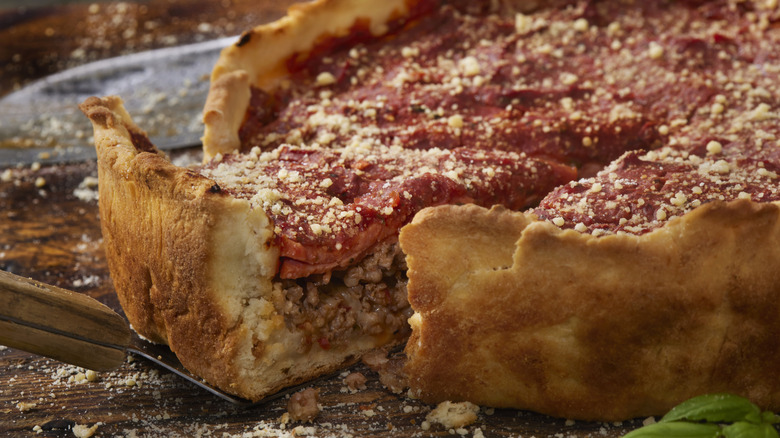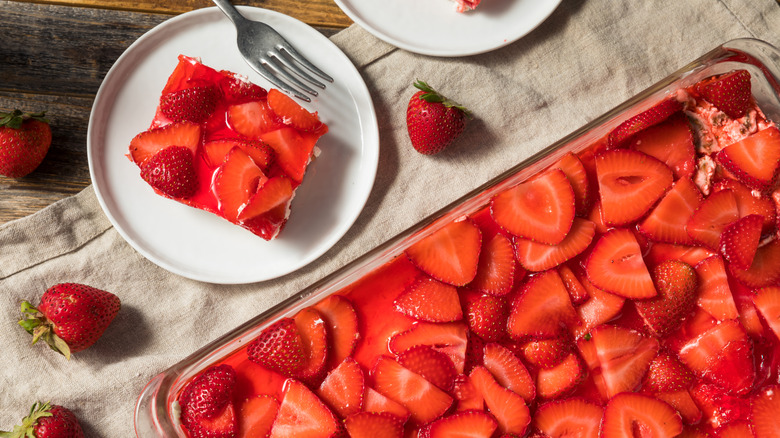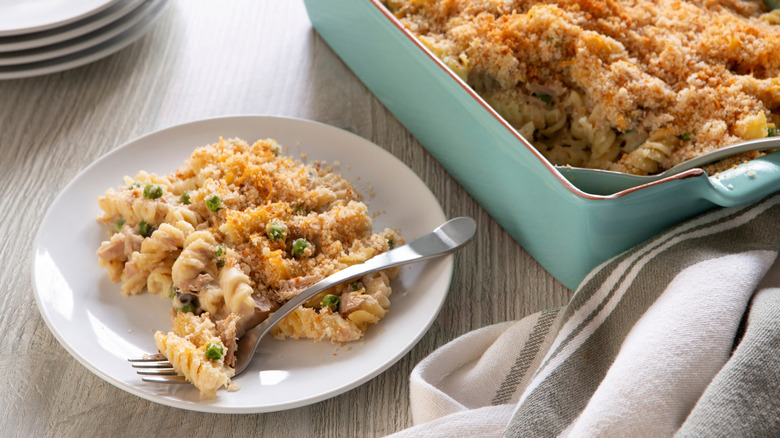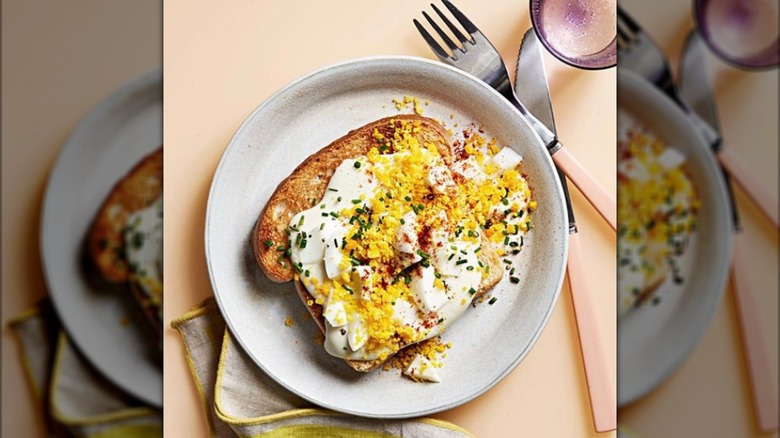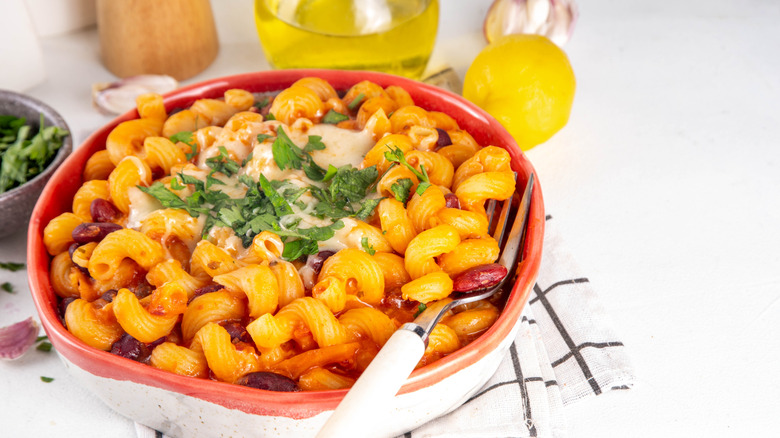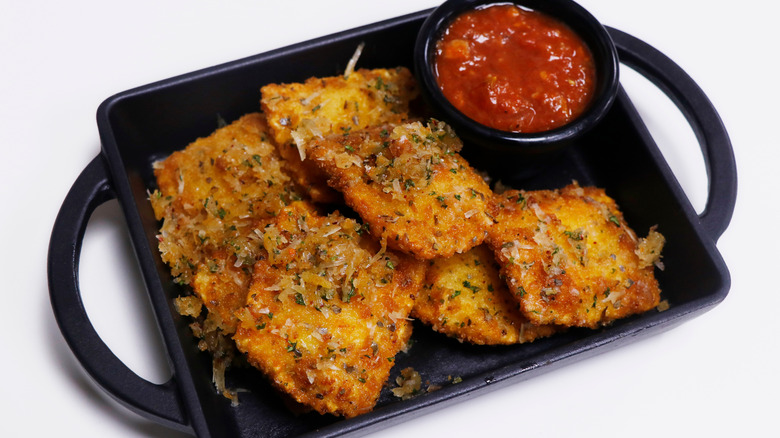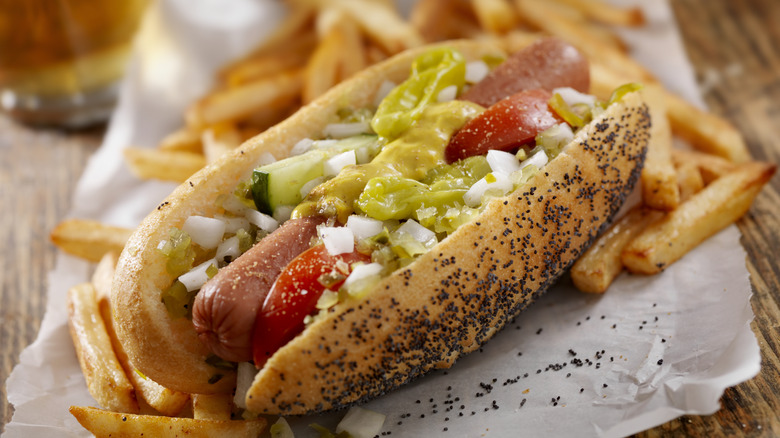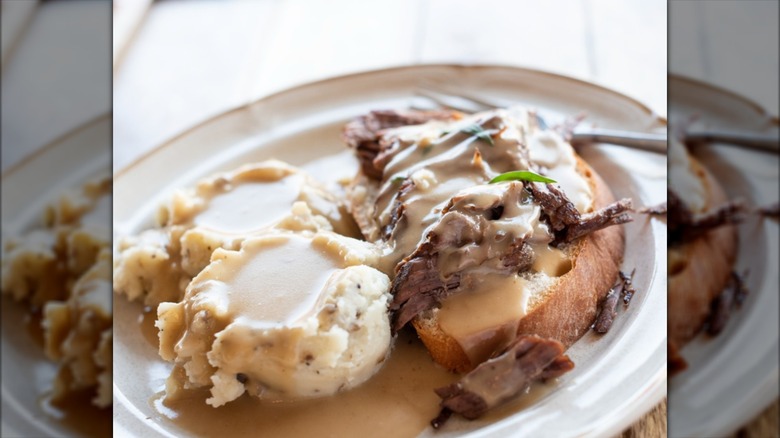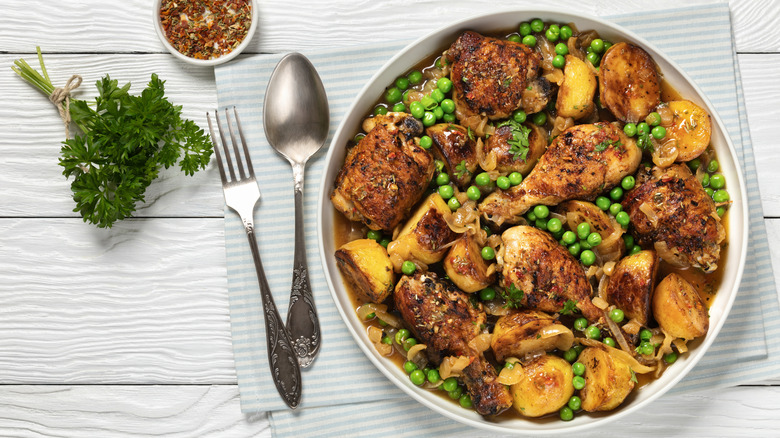Midwestern Comfort Foods You Need To Try Before You Die
Every region in the United States seems to have a signature cuisine. The South has Tex-Mex and barbecue. The Gulf Coast has Cajun and Creole influences. New England has seafood like lobster and shellfish like oysters. But what, exactly, are the Midwestern states known for?
This diverse region is known for its agriculture acumen, with much of the country's corn, cheese, potatoes, and beef being grown or raised in the area. So it's only logical that these fresh, delicious ingredients would be incorporated into their popular dishes. But over the years, the Midwest has accumulated a plentiful supply of creative recipes that incorporate all kinds of ingredients — both those that were homegrown and invented in the U.S. and others that have their roots abroad.
Slowly, the region has become known for a few signature dishes that perfectly encapsulate the homey, comforting, satisfying Midwestern persona. Read on to learn about some of the Midwest's most popular comfort dishes so you can decide which one to try first.
Tater tot casserole
While many people think of tater tots as a crispy and delicious side for sandwiches like burgers or BLTs, in the Midwest they're the base for a different regional favorite: tater tot casserole. Also called tater tot hotdish depending on the state, this Midwestern must-have is the ultimate comfort food.
Tater tots were invented in the early 1950s and began being sold widely by 1956. Not long after, this dish became a mainstay in the Midwest throughout the 1960s and 1970s. Though there are many variations and recipes, there are a few commonalities between most casseroles; they usually consist of ground meat mixed with veggies and condensed soup that is then topped with tater tots. Many recipes also call for shredded cheese to create a melty, savory, delicious combination of flavors. The final product is a hearty meal that many Midwesterners can wax poetic about — it's not uncommon for it to rank high among their nostalgic childhood favorites.
St. Louis style ribs
Barbecue fans have strong preferences over which style they prefer; from the bold, slow-roasted flavor of Texas to the vinegary smoked style of Eastern North Carolina, each state has its own unique approach. While the South has its own distinct take on barbecue, St. Louis-style barbecue is one of the prevailing favorites in the Midwest — and St. Louis barbecue is arguably most well-known for its ribs.
This mouthwatering dish is a take on classic spare ribs that first became popular by the mid-1900s. St. Louis ribs are cut to have more meat and more fat, making them extra tender and flavorful. They're slowly cooked in a smoker over the course of many hours, creating a tender and delicious final dish that falls off the bone. Once cooked, ribs are coated in a tomato-based sauce that is equal parts tangy, sweet, and spicy. This sauce is distinct from other regions' barbecue sauces thanks to its thickness that glazes the meat and creates an extra-indulgent exterior. It is also typically used to baste the ribs as they cook, keeping them extra moist and infusing them with even more flavor.
Funeral potatoes
Despite the morbid name, funeral potatoes are a Midwestern staple at almost any family gathering — both happy and sad. The dish supposedly gets its name from its predictable presence at Mormon funerals, but over time traditions have changed. The cheesy, delicious dish is also now found at other events like holidays, graduation parties, or picnics throughout the Midwest.
This casserole-like dish is similar in flavor to au gratin or scalloped potatoes, but is made with more accessible, everyday ingredients and techniques. Funeral potatoes are usually made with frozen, shredded hash brown potatoes (instead of laborious, thinly sliced rounds). To finish the funeral potatoes, cheese, sour cream, and condensed soup are all incorporated and then topped with this dish's signature ingredients: cornflakes.
Like many Midwestern delights, funeral potatoes aren't exactly healthy; generous helpings of cheese, butter, and potatoes create a hearty, high-calorie side — but it's worth indulging every once in a while to satisfy your craving for the ultimate comfort food. But if you're looking to lighten it up, you could also make some easy swaps or additions — like adding fresh or frozen veggies like broccoli — to the shredded potatoes before baking.
Cincinnati chili
To many, cornbread and chili is a strictly Southern dish. But Cincinnati has taken this classic from below the Mason-Dixon line and added its own unique twist. The Ohio take on chili consists of meat sauce served over top of spaghetti and topped with mounds of shredded cheese, beans, and onions.
This now iconic dish is loosely based on the Greek dish saltsa kima, and was first introduced to the Midwest in the 1920s by Tom and John Kiradjieff who had immigrated to the U.S. from what is now Northern Greece. They opened a chili parlor and began serving this dish — and Cincinnati chili was born. The savory, cheesy dish was further popularized by local restaurant chain Skyline when it first opened in 1949.
The Skyline and Cincinnati chili have since become synonymous, with Cincinnati chili often referred to as just "Skyline chili." The restaurant even ships its signature dish across the country, so those craving a taste of the Midwest can get it sent straight to their door with just a few clicks. You can also recreate the recipe in the comfort of your own kitchen with one of many copycat recipes available online, allowing you to customize it to your exact tastes.
Buckeyes
Different people think of different things when they hear the word "buckeye." While some picture Ohio State's dominant football team, others think of the Ohio state tree that drops its signature dark brown buckeye nut every autumn. But our favorite type of buckeye? The delicious, peanut-buttery cookie that's beloved throughout the state — and the rest of the Midwest.
Buckeye candy is designed to mimic the look of the buckeye nut, with a dark brown exterior and small, lighter brown center. First created in 1919 by the Buckeye Candy Company, this sweet treat is made by creating a simple peanut butter mixture and then dipping it in a chocolate coating. Similar in flavor to a Reese's Peanut Butter Cup, the candy is a popular snack at Ohio State football games (thanks to sharing a name with the team mascot) as well as at parties and other get-togethers — though there really is no bad time to indulge in this delicious sweet treat.
Deep-dish pizza
While New York may be known for its delicious Neapolitan-style, thin-crust pizza, the Midwestern metropolis of Chicago has its own signature pie: deep dish. Though the origins of deep-dish pizza are murky (Pizzeria Uno is credited by some with inventing it, while others are sure it was Rosati's Authentic Chicago Pizza), there's something everyone can agree on: it's cheesy, delicious, and a Midwestern staple.
Deep-dish pizza is made by lining a cast iron pan with pizza dough. The exterior crust layer is then covered in cheese and the chosen toppings before adding the sauce on top. And there's a reason for this reverse-ordering; the thick crust takes so long to bake, that the cheese and toppings would burn if they were exposed to the oven for such a long stretch. Instead, adding the sauce on top helps protect the ingredients and preserve the flavor. Though deep-dish pizza isn't for everyone (Anthony Bourdain went so far as to call it "an abomination"), it's a beloved dish by Chicago natives and others across the Midwest.
Strawberry pretzel salad
The name of this Midwestern delicacy might be a bit misleading. The strawberry Jell-O dessert doesn't much resemble a salad, but it's a delicious addition to a potluck, picnic, or other gathering.
Though some attribute this dish's origins to the South, it's also a staple among Midwesterners. It's especially popular during the warmer summer months thanks to the simple recipe that is easy to make, requires little baking, and sets up quickly in the fridge for a cool, refreshing recipe.
To create the crust, mix the pretzels, sugar, and butter, press the mixture into a pan, and bake. Once cooled, you make the filling (some call for cream cheese while others prefer Cool Whip). Then comes the pièce de résistance: the strawberry Jell-O topping. Make the Jell-O according to the box directions, then scatter strawberries over the top before putting in the fridge to set. The result is a salty and sweet dessert that is crunchy, creamy, and unbelievably satisfying.
Tuna noodle casserole
Though this dish has its roots in the Pacific Northwest, it was popularized in the 1950s in the Midwest — and has remained a staple in the region ever since. The recipe became even more popular once Campbell's created its condensed soups, eliminating the need for a time-consuming béchamel base to make this fishy casserole. It grew so much in popularity over the years that iconic chef James Beard even printed his own version of the recipe in 1952.
Despite its many critics, this dish is firmly cemented in Midwestern culture, possibly because it is affordable, the ingredients are readily available in all seasons, it's fast and easy to make, and it's hearty fare for the long and brutal Midwest winters. Tuna noodle casserole's association with the Midwest is also possibly due to the dish's similarities to many Minnesota hotdishes, with most recipes calling for protein, vegetable, and condensed soup. While the ingredients may seem like an unlikely pairing (tuna, egg noodles, and cheese?), many who grew up across the Midwest crave this childhood meal well into adulthood.
Eggs a la goldenrod
This recipe, originally shared in the 1896 edition of The Fannie Farmer Cookbook from The Boston Cooking School, is unique by today's standards. Hard-boiled eggs are first separated, and the whites are mixed in with a thin white sauce, poured over toast, and topped with the grated yolks. The versatile dish works as well for breakfast as it does for dinner, and its affordability made it a prevalent meal in many Midwestern households throughout the decades since its invention.
The egg-and-toast base is also the perfect foundation to get creative, allowing you to top the dish with almost anything you can dream up. Try adding classic breakfast staples like bacon or sausage. More creative alternatives include salmon (fillets or smoked), vegetables like asparagus or mushrooms, and herbs like scallions or dill. But the possibilities don't end with the toppings; instead of toast, some recipes call for swapping in another carb base like biscuits.
Beef and macaroni casserole
Unsurprisingly, another hearty casserole tops the list of Midwestern favorites. Beef and macaroni casserole, also called Johnny Marzetti, is rumored to have originated in Columbus, Ohio. The Italian Marzetti family settled in Ohio and opened a well-known restaurant (still recognized today for its line of Marzetti dressings). The noodle, ground beef, cheese, and tomato mixture was allegedly a mainstay on the restaurant menu — though the family has never confirmed or denied these claims. Whatever its origins, the dish quickly garnered a cult following not just in Ohio, but across the Midwest.
Other states in the Midwest have their own variations of this recipe — with Minnesotans calling theirs "beef and macaroni hotdish" and include a few extras like Worcestershire sauce and hot sauce. The basic DNA of the dish, however, remains the same: a savory mixture of beef and noodles (with a few vegetables for good measure) topped with a layer of gooey melted cheese. What's not to love?
Toasted ravioli
Nothing screams St. Louis quite like toasted ravioli — this delicacy is almost as representative of this Midwestern city as the Cardinals baseball team or the Gateway Arch. Breaded and fried ravioli make the perfect salty and savory snack; ideal as an appetizer or mid-afternoon treat. It is a favorite among St. Louis delicacies (though they have many including gooey butter cake and Provel pizza).
Typically made with small, square, cheese-and-meat-filled ravioli, the dish is rumored to have been accidentally created in St. Louis's Italian neighborhood, The Hill, when ravioli was dropped into oil instead of water by mistake. Today's variation is usually served with a side of marinara, giving them a similar feel to a mozzarella stick but with a crispier, crunchier exterior.
If you can't make it to St. Louis in person, it's easy enough to recreate this iconic dish with the help of premade, store-bought ravioli. Use a typical breading technique (egg wash, flour, and breadcrumbs) before frying them in your preferred oil until golden brown. You can even air-fry them for a healthier, oil-free alternative.
Chicago-style hot dog
While ketchup and mustard are the old standby for most, a Chicago-style hot dog takes it up a notch — or seven. A classic Chicago dog is known for its seven essential ingredients: white onion, sweet pickle relish, a dill pickle, tomato slice, pickled peppers, and celery salt. An all-beef hot dog and poppy seed bun are also a must.
While classic hot dogs are representative of a different major city — New York — hot dogs grew in popularity during the Great Depression in Chicago because of their affordability. To add some extra nutrients, vegetables were added on top and, eventually, a few topping trends emerged to create a signature the city would later become known for.
But the toppings aren't the only requirement. Chicago hot dogs are boiled or steamed — not grilled — so you won't find the traditional variation at a backyard barbecue — though many people are willing to make an exception. While several restaurants in Chicago, like Portillo's or Gene and Jude's, have become known for serving up this specific type of dog, they're also usually available at any hot dog stand or sporting event if you're looking to indulge.
Hot beef sandwich
This Midwestern beef sandwich is beloved throughout Minnesota and Iowa (though the dish has spread throughout North and South Dakota and other parts of the Midwest, too). This rich, decadent meal consists of an open-faced sandwich with white bread topped with slices of roast beef, mashed potatoes, and buckets of rich brown gravy. Known as a "beef commercial" sandwich in parts of Minnesota, it's a filling meal (perfect for harsh winters) that can be found on many local mom-and-pop restaurant menus.
The name and origins of this sandwich are shrouded in mystery, with different people having different theories. Some suspect the "commercial" refers to salesmen and other business professionals who would often order the meal; others say it refers to the USDA's grading system for commercial beef. While there's no definitive answer, one thing is clear: This hearty sandwich is a must-try for anyone traveling on the I-90 corridor through Minnesota.
Chicken Vesuvio
This Italian-American dish hails from Chicago and, like many other Midwestern comfort foods, the Chicken Vesuvio has murky origins. Some believe that the dish was first created by Vesuvio Restaurant in the 1930s. Others suspect it is a variation of a dish from the greater Naples area of Italy's Mount Vesuvius (though historians seem to disbelieve this theory). Either way, the dish rose to popularity in the Windy City in the latter half of the 1900s, becoming a mainstay on most fine dining menus. Though Chicken Vesuvio was originally associated with fine dining, many Midwesterners — and especially Chicagoans — grew up eating it at home, too.
To create this delicious dish, skin-on, bone-in chicken is pan roasted with potatoes, herbs, and a generous helping of garlic, butter, and wine to create a rich sauce. The dish is then topped with peas and fresh lemon juice before being garnished with parsley to blend quintessential Italian flavors.
